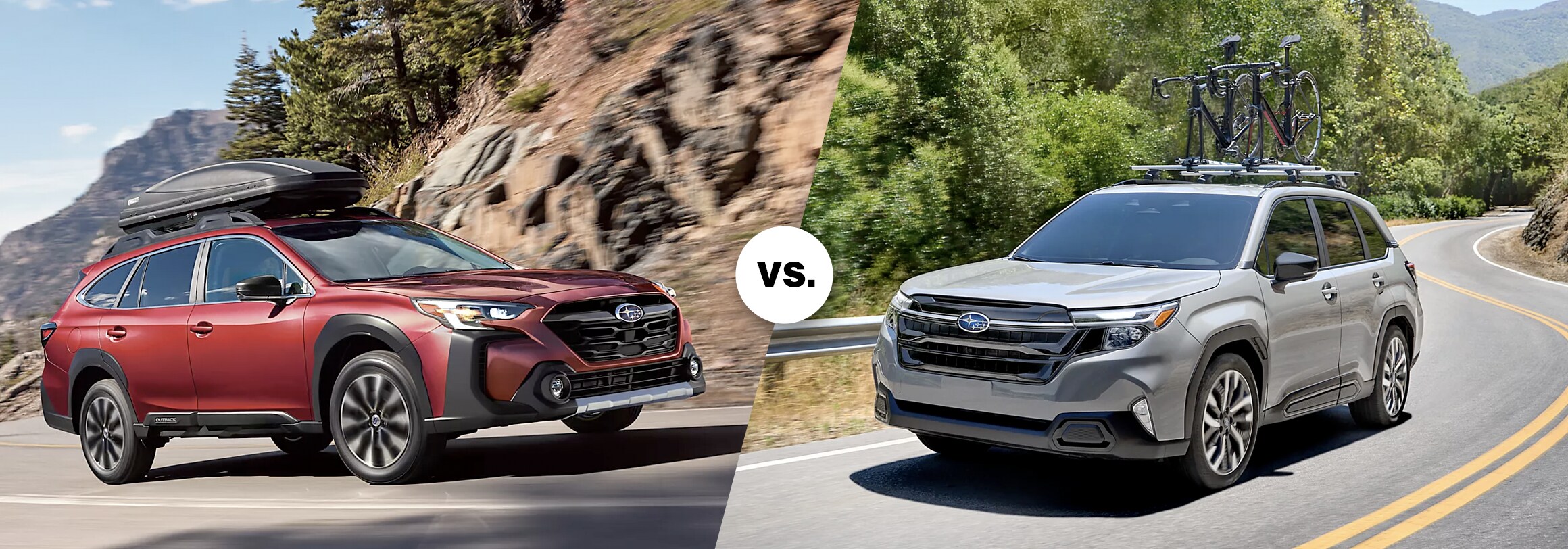
2025 Forester vs 2025 Outback

Overview
Subaru has had the Forester and Outback in its lineup since the 1990s, with each offering a different take on the company’s winning formula. For the 2025 model year, both vehicles continue to offer Subaru's renowned all-wheel drive system, spacious interiors, and other advantages. We decided to explore how these two popular crossovers compare, with the hope of helping potential buyers understand their similarities and differences to determine which one best suits their needs.
View Inventory
Generations
The 2025 model marks the start of the sixth-generation Forester, which is all new with a revamped exterior and tech-centric interior. The current (sixth-generation) Outback has been around since model year 2020, but it received a substantial refresh for 2023 and now looks more rugged than ever.
Both models are based on the Subaru Global Platform (SGP), which debuted with the 2016 Impreza. The SGP aids the company in streamlining engineering and production while improving strength and rigidity (which benefits both safety and ride quality).
Trims
The 2025 Forester has five trims: Base, Premium, Sport, Limited, and Touring. Each of them offers distinct styling elements, with the Sport featuring eye-catching and trendy bronze accents and the Touring providing a more elegant appearance.
The 2025 Outback offers a wider range of trims, with nine: Base, Premium, Onyx Edition, Limited, Touring, Onyx Edition XT, Wilderness, Limited XT, and Touring XT. This variety allows buyers to choose a version that best fits their lifestyle and preferences, from the value-oriented entry-level model to the off-road-focused Wilderness and the loaded Touring XT.
Pricing
Cost takes a surprising twist with this comparison. The 2025 Forester has a starting price of $29,695, compared to $28,895 for the Outback – a difference of just $800. There’s a similar gap favoring the Outback with the Premium trim, but lower pricing tilts toward the Forester as you go further up the range. For instance, the Forester’s highest grade, the Touring, has an MSRP of $39,995, compared to $40,345 for the Outback Touring. In addition, there’s no Forester equivalent to the Outback Touring XT,which stickers at $42,795.
Powertrains
The 2025 Forester has a revised 2.5-liter four-cylinder boxer engine, which puts out 180 horsepower and 178 lb.-ft. of torque. This powertrain offers improved mid-range torque, ensuring responsive acceleration in everyday driving situations.
The 2025 Outback offers two engine options, catering to different driving preferences. The standard 2.5-liter engine, which is shared with the Forester, produces 182 horsepower and 176 lb.-ft. of torque, while the available 2.4-liter turbocharged four-cylinder in the XT trims makes a more robust 260 horsepower and 277 lb.-ft. of torque.
Both vehicles feature Subaru's Lineartronic CVT (continuously variable transmission), which has been refined for 2025 for improved performance and reduced noise. For the Outback, the transmission is an eight-speed manual mode across all trims, while the Forester provides this feature only on the Sport, Limited, and Touring.
Towing
The 2025 Forester can tow up to 1,500 pounds, making it ideal for pulling a compact utility trailer or small boat. Towing capacity increases to 2,700 pounds for the Outback (and 3,500 pounds for the XT and Wilderness trims), giving this Subaru a greater trailering edge.
Fuel Economy
The Forester excels in fuel efficiency, with EPA estimates of 26 mpg in the city and 33 mpg on the highway. The Outback is also quite efficient, especially considering its larger size: with the same 2.5-liter engine, it delivers nearly identical results of 26 mpg around town and 32 mpg on the open road. The more powerful XT trims maintain respectable efficiency at 22 mpg in the city and 29 mpg on the highway.
Off-Road Capability
The proprietary Symmetrical All-Wheel Drive system is standard on the Forester and Outback, as it does on all Subaru models (except the BRZ) for excellent traction in challenging conditions. The Forester boasts 8.7 inches of ground clearance across all trims, while the Outback offers the same 8.7 inches on most version and an increased 9.5 inches on the adventure-ready Wilderness.
The Forester Premium and above are equipped with X-MODE, which enhances off-road capability. The Sport, Limited, and Touring feature a dual-function X-MODE system with Snow/Dirt and Deep Snow/Mud modes for even greater versatility. The Outback matches this capability with its own X-MODE system, including the dual-function version on higher trims. The Outback Wilderness takes things a step further with its exclusive advanced dual-function X-MODE, featuring additional low-speed/low-ratio gradient control for tackling even more challenging terrain.
Interior and Cargo Space
The Forester has a spacious cabin with an interior volume up to 110.8 cubic feet (it’s 106.6 cubic feet in most trims with the standard panoramic moonroof). Behind the rear seats, there is 29.6 cubic feet of cargo space (27.5 cubic feet with the moonroof), which expands to 74.1 cubic feet (69.1 cubic feet for moonroof-equipped Foresters) when the back row is folded down.
The Outback's overall passenger volume is comparable, at 109.0 cubic feet (107.5 with a moonroof). However, the Outback does offer modestly more cargo space: 32.6 cubic feet behind the second row and 75.6 cubic feet behind the first row.




